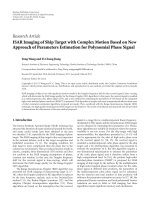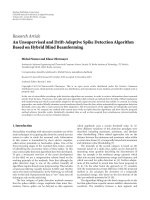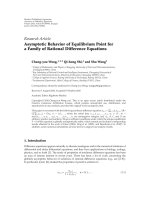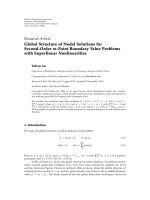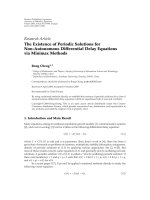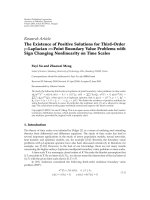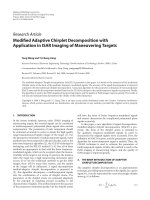Báo cáo hóa học: "Research Article ISAR Imaging of Ship Target with Complex Motion Based on New Approach of Parameters Estimation for Polynomial Phase Signal" docx
Bạn đang xem bản rút gọn của tài liệu. Xem và tải ngay bản đầy đủ của tài liệu tại đây (1.83 MB, 9 trang )
Hindawi Publishing Corporation
EURASIP Journal on Advances in Signal Processing
Volume 2011, Article ID 425203, 9 pages
doi:10.1155/2011/425203
Research Article
ISAR Imaging of Ship Target with Complex Motion Based on New
Approach of Parameters Estimation for Polynomial Phase Signal
Yong Wang and Yi-Cheng Jiang
Research Institute of Electronic Engineering Technology, Harbin Institute of Technology, Harbin 150001, China
Correspondence should be addressed to Yong Wang,
Received 25 September 2010; Revised 20 January 2011; Accepted 9 March 2011
Academic Editor: M. Greco
Copyright © 2011 Y. Wang and Y C. Jiang. This is an open access article distributed under the Creative Commons Attribution
License, which permits unrestricted use, distribution, and reproduction in any medium, provided the original work is properly
cited.
ISAR imaging of ships at sea with significant motion results in the Doppler frequency shift for the received signal is time-varying,
which will deteriorate the ISAR image quality for the Range-Doppler (RD) algorithm. In this paper, the received signal is modeled
as a multicomponent cubic phase signal (CPS), and a new method for estimating the parameters of CPS based on the integrated
high-order matched phase transform (IHMPT) is proposed. This algorithm is simpler and more computational efficient than some
of other parameters estimation algorithms proposed previously. Then, combined with the Range-Instantaneous-Doppler (RID)
technique, the high quality instantaneous ISAR images can be obtained. The results of simulated and measured data are provided
to demonstrate the effectiveness of the new method proposed.
1. Introduction
The Inverse Synthetic Aperture Radar (ISAR) technique has
attracted the attention of many scholars all around the world,
and many useful results have been obtained in the past
two decades [1–4], especially for the ISAR imaging of plane
target. The ISAR imaging of ship target is also very important
in the national defense, such as the target recognition and
battlefield awareness [5, 6]. The imaging condition for
ship target is more complicated than the plane due to the
extreme sea environment. This sea-induced motion results in
chaotic, complex, three-dimensional (3D) motion and does
not conform to the ISAR imaging assumptions of planar,
constant rate rotation. In this case, the Doppler frequency
shift for the received signal is time-varying, which will
deteriorate the ISAR image quality for the Range-Doppler
(RD) algorithm.
The Range-Instantaneous-Doppler (RID) algorithm was
presented for ISAR imaging of maneuvering target in [7–
10], where the Doppler analysis for RD algorithm is replaced
by the time frequency analysis, such as the DechirpClean
method [11], the Radon-Wigner transform [12], and the
adaptive Chirplet decomposition algorithm [13]. These
algorithms are based on the assumption that the received
signal in a range bin is a multicomponent linear-frequency-
modulated (LFM) signal, and the instantaneous ISAR images
can be obtained by estimating the parameters of it. Hence,
these algorithms are suitable in situations where the maneu-
verability is not too severe. For the ship target w ith high
maneuverability, the algorithms presented in [11–13]will
not be appropriate for the sake of high-order phase term
in the received signal. In [14, 15], the received signal is
modeled as multicomponent cubic phase signal for the ship
target, and a TC-DechirpClean algorithm was presented to
estimate the par ameters of it. But this algorithm requires a
two-dimensional maximization to estimate the parameters
of the cubic phase signal, and it therefore suffers from a
high computational loa d. In [16], the product high-order
matched-phase transform (PHMT) is proposed for ISAR
imaging of ship target by the authors. By the multiplication
of high-order matched-phase transform slices for the cubic
phase signal at different time positions, the parameters of
the multicomponent cubic phase signal can be estimated.
But the selection and total number of time positions will
influence the parameters estimation accuracy. In [17, 18], the
polynomial Fourier transform and local polynomial Fourier
transform are used in ISAR or SAR imaging, but these
algorithms require significant memory and calculations.
2 EURASIP Journal on Advances in Signal Processing
x
y
z
R(x
1
, y
1
, z
1
)
P
β
Ω
Figure 1: Geometry of ISAR image for ship target.
In this paper, the received signal is modeled as mul-
ticomponent cubic phase signal (CPS), and the integrated
high-order matched phase transform (IHMPT) is presented
to estimate the parameters of it. This method requires
only one-dimensional maximization, and the parameters
of each component can be estimated efficiently. Then, the
high-quality instantaneous ISAR images can be obtained
combined with the RID technique.
This paper is organized as follows. In Section 2, the cubic
phase signal model for the received signal of ship target in
ISAR imaging is established; in Section 3, the principle of
IHMPT is presented, and the ISAR imaging algorithm of
ship target based on the IHMPT is discussed in Section 4;
the results for simulated and measured data are given in
Section 5; Section 6 is the conclusion for the paper.
2. Cubic Phase Signal Model for the
Received Signal
In this section, we assume that the motion compensation
(including the range alignment and phase adjustment) has
been completed, and the ISAR imaging geometry for ship
target is shown in Figure 1.
In Figure 1, the coordinate of the radar line-of-sight
(LOS) is xyz and the synthetic vector Ω denotes the angular
velocity of the target. The x axis is located on the z
− Ω plane,
and the unit vector of LOS is r, which overlaps the z axis. The
point O is the rotating centre of the ship target, and we use
the vector R(x
1
, y
1
, z
1
) to denote the position of a scatterer
P on the target. The Doppler frequency shift of the scatterer
induced by the rotation can be written as [8]
ω
=
4π
λ
[
(
Ω
× R
)
• r
]
,(1)
where λ is the wavelength of the radar,
× denotes the outer
product, and
• denotes the inner product.
For ship target with high maneuverability, the synthetic
vector Ω can be approximated as follows:
Ω
≈ Ω
0
+ α
0
t + γ
0
t
2
,(2)
where Ω
0
, α
0
,andγ
0
are the constant term, first-order term,
and second-order term coefficients of Ω,respectively.t is the
azimuth time. Then, we can rewrite (1) as follows:
ω
=
4π
λ
[
(
Ω
× R
)
• r
]
=
4π
λ
[
Ω
•
(
R
× r
)
]
=
4π
λ
Ω
0
• μ + α
0
• μt + γ
0
• μt
2
,
(3)
where μ
= R × r. Then, for the Doppler frequency ω, the
received signal for scatterer P can be written as
s
0
(
t
)
= A
0
exp
jωt
=
A
0
exp
j
4π
λ
Ω
0
• μt + α
0
• μt
2
+ γ
0
• μt
3
,
(4)
where A
0
is the amplitude. From ( 4), we can see that for a
scatterer on the ship target, the received sig nal has the form
of cubic phase signal (CPS). Hence, for multiple scatterers in
a certain range bin, the received signal can be characterized
as
s
(
t
)
=
K
k=1
A
k
exp
j
4π
λ
Ω
0k
• μ
k
t + α
0k
• μ
k
t
2
+ γ
0k
• μ
k
t
3
=
K
k=1
A
k
exp
j
a
k,1
t + a
k,2
t
2
+ a
k,3
t
3
,
(5)
where
a
k,1
=
4π
λ
Ω
0k
• μ
k
,
a
k,2
=
4π
λ
α
0k
• μ
k
,
a
k,3
=
4π
λ
γ
0k
• μ
k
,
(6)
and K is the number of scatterers in a range bin, A
k
(k =
1, 2, K) is the amplitude of each scatterer, and a
k,l
|
3
l
=1
are
the phase coefficients to be determined.
It can be seen from (5) that the received signal in a
range bin can be modeled as multicomponent CPS for ISAR
imaging of ship target with high maneuverability. In this
paper, a new algorithm called IHMPT is proposed to estimate
the parameters of the multicomponent CPS. Combined with
the RID algorithm, the high-quality instantaneous ISAR
images can be obtained.
EURASIP Journal on Advances in Signal Processing 3
0
2000
4000
6000
8000
0 100 200 300 400 500
Relative third-phase derivative
Relative amplitude
(a) HMPT slice at n =−55
0 100 200 300 400 500
Relative third-phase derivative
Relative amplitude
12
10
8
6
×10
5
(b) IHMPT for the signal
Figure 2: Results of the numerical example.
3. Principle of IHMPT
3.1. The High-Order Matched Phase Transform (HMPT).
Consider the discrete form of monocomponent CPS with the
following structure:
s
(
n
)
= A
0
exp
j
a
1
n + a
2
n
2
+ a
3
n
3
,
−
(
N
− 1
)
2
≤ n ≤
(
N
− 1
)
2
,
(7)
where N is the length of the signal, and it is assumed to be
an odd integer, A
0
is the amplitude, and a
1
, a
2
, a
3
are the
coefficients to be determined.
The high-order matched phase transform (HMPT) for
s(n)wasproposedin[16] as follows:
HMPT
(
n, σ
)
=
(N−1)/2
m=0
[
s
∗
(
n + m
)
s
(
n
− m
)
]
2
[
s
(
n +2m
)
s
∗
(
n
− 2m
)
]
×
exp
− jσm
3
.
(8)
Substitute (7) into (8), we obtain
HMPT
(
n, σ
)
= A
6
0
(N
−1)/2
m=0
exp
j
(
12a
3
− σ
)
m
3
.
(9)
It is obvious that HMPT is independent on n without the
consideration of noise. This means that in the (n, σ) plane,
HMPT(n, σ) is a line parallels to the n axis.
We can see from (9) that
|HMPT(n, σ)| peaks along the
curve
σ
= 12a
3
. (10)
Hence, the a
3
can be estimated by the maximum value of
|HMPT(n, σ)| as
a
3
= arg max
σ
|HMPT
(
n, σ
)
|
12
. (11)
Then, the other parameters can be estimated by the dechirp
technique and the Fourier transform.
3.2. The Definition of IHMPT. From (8), we can see that
the HMPT has the nonlinearity character. Hence, for mul-
ticomponent CPS, the cross-terms will appear. In this paper,
the IHMPT is proposed to reduce the cross-terms between
different components. The definition of IHMPT is
IHMPT
(
σ
)
=
n
|HMPT
(
n, σ
)
|. (12)
For the IHMPT, the cross-terms can be reduced due to
the dispersion in the HMPT(n, σ) domain, and the auto-
terms can be amplified due to the integration operation.
Hence, the IHMPT is appropriate for the parameters esti-
mation of multicomponent CPS. Furthermore, from the
analysis above, we can see that the IHMPT requires only one-
dimensional maximization, and it is computational efficient,
which is quite suitable in ISAR imaging.
3.3. Numerical Example. In this section, we use the numer-
ical example to demonstrate the effectiveness of IHMPT in
the suppression of cross-terms for multicomponent CPS. For
convenience, we assume that the simulated signal consists of
two components with the following structure:
s
(
n
)
=
2
k=1
A
k
exp
j
a
k,1
n + a
k,2
n
2
+ a
k,3
n
3
. (13)
The sampling rate is assumed to be unity and n
∈
[−255, 255]. The parameters are shown in Tabl e 1.(Inorder
4 EURASIP Journal on Advances in Signal Processing
Raw data
Motion
compensation
ξ
= 1
Data of ξ th
range cell
Approximated as
K CPS, k
= 1
FFT
Dechirp
Estimate
^α
k,2
Dechirp
Estimate
^α
k,3
Estimate ^α
k,1
,
^
A
k
Subtract the
estimated component
k
≥ K?
Output the parameters
of all CPSs
ξ
≥ M?
Instantaneous ISAR
images based on IHMPT
ξ
= ξ +1
Yes
Yes
No
No
k
= k +1
Figure 3: Flow chart of ISAR imaging based on IHMPT algorithm.
Table 1: Parameters of the simulated signal.
Components (k) A
k
a
k,1
a
k,2
a
k,3
12π/85× 10
−3
1 × 10
−5
21.5π/4 −1 × 10
−3
−6 × 10
−5
to avoid ambiguities arising from the cyclic nature of spectral
transforms of sampled signals [19], it is assumed that
|a
k,i
|≤
π/(i!(N/2)
(i−1)
), i = 1, 2,3.Nis the length of the signal.)
Figure 2(a) is the HMPT slice at n
=−55. We can see
that the cross-terms appear for the nonlinearity of HMPT,
and the auto-terms cannot be detected correctly. Figure 2(b)
is the IHMPT for the signal. It is obvious that the cross-
terms have been suppressed greatly. At the same time, the
auto-terms have been amplified greatly, which is appropriate
for the parameters estimation of multicomponent CPS.
The reason for Figure 2(b) showing one peak is that the
amplitudes for the two components are different: one is 2 and
the other is 1.5, which is shown in Tab le 1 . This peak denotes
the a
3
parameter for the component with amplitude 2, and
after this component is subtracted from the original signal,
the other peak for the a
3
parameter for the component with
amplitude 1.5 will appear.
The results for the example have demonstrated the
validity of the IHMPT.
4. ISAR Imaging of Ship Target
Based on IHMPT
The ISAR imaging algorithm of ship target with high
maneuverability can be illustrated as follows.
Step 1. Suppose the received signal in a range bin is K
components CPS of the discrete form
s
(
n
)
=
K
k=1
A
k
exp
j
a
k,1
n + a
k,2
n
2
+ a
k,3
n
3
,
−
(
N
− 1
)
2
≤ n ≤
(
N
− 1
)
2
,
(14)
where A
k
is the amplitude of kth component and a
k,l
|
3
l
=1
is
the lth-order phase coefficients for the kth component.
Step 2. Initialize k
= 1, s
1
(n) = s(n).
Step 3. Estimate
a
k,3
by finding the peak of IHMPT(σ).
Step 4. Construct the reference signal
s
ref1
(
n
)
= exp
−
j a
k,3
n
3
(15)
and multiply it with the signal s
k
(n); we obtain
s
d
(
n
)
= s
k
(
n
)
· s
ref1
(
n
)
= s
k
(
n
)
exp
− ja
k,3
n
3
. (16)
EURASIP Journal on Advances in Signal Processing 5
w
v
u
O
Radar
Yaw
Pitch
LOS
Roll
x
y
z
w
v
u
O
r
Y
a
Y
Y
w
a
P
i
t
c
h
L
R
o
y
Figure 4: Coordinate systems of Radar and ship target.
40
20
0
60
40
20
0
−20
−40
−60
−20
0
20
Relative length
Relative width
Relative height
Figure 5: Simulated ship model.
Step 5. Estimate a
k,2
by the cubic phase function presented
as follows:
a
k,2
=
arg max
ξ
(N−1)/2
m
=0
s
d
(
n + m
)
s
d
(
n
− m
)
exp
−
jξm
2
2
.
(17)
Step 6. Construct the reference signal
s
ref2
(
n
)
= exp
−
j a
k,3
n
3
− ja
k,2
n
2
. (18)
Then, estimate
a
k,1
by dechirping the original signal with
s
ref2
(n) and finding the Fourier transform peak:
a
k,1
= arg max
a
k,1
(N−1)/2
n=−
(
N
−1
)
/2
s
k
(
n
)
· s
ref2
(
n
)
· exp
−
ja
k,1
n
.
(19)
Table 2: Simulation parameters.
Amplitude (
◦
) Angular velocity (radian/s)
Roll 15 2π/14
Pitch 4 2π/7
Yaw 2 2π/14
Step 7. Estimate
A
k
as follows:
A
k
=
1
N
(N−1)/2
n=−
(
N
−1
)
/2
s
k
(
n
)
e
− j(a
k,1
n+a
k,2
n
2
+a
k,3
n
3
)
. (20)
Step 8. Subtr a ct the estimated kth component from s
k
(n):
s
k+1
(
n
)
= s
k
(
n
)
−
A
k
e
j(a
k,1
n+a
k,2
n
2
+a
k,3
n
3
)
. (21)
Step 9. Set k
= k + 1, and repeat the above steps until k =
Kor the residual energy of the signal is less than a threshold
ε (example, 1% of the original signal).
Based on the above procedure, we can obtain the
instantaneous ISAR image at different time positions based
ontheIHMPT,whichisillustratedinFigure 3.Thenumber
of time history series is P, and each has the length of M.
After computing the IHMPT of each range bin and time
sampling, the P frames M
× P instantaneous ISAR images
can be obtained.
5. Examples
In this section, the results of simulated and measured
data are provided to demonstrate the effectiveness of the
IHMPT algorithm for ISAR imaging of ship target with high
maneuv erability.
5.1. Simulated Data. Here, we use the simulated data of
ship target with three-dimensional rotation (including the
roll, pitch, and yaw) to demonstrate the effectiveness of the
IHMPT algorithm.
The coordinate systems of Radar and the ship target are
shown in Figure 4, where the (u, v, w)frameisdefinedas
the Radar coordinate frame and the (x, y, z)frameisdefined
as the target coordinate frame. We assume that the Radar is
located at the origin O
of the (u, v, w) coordinate, and the
initial location of the rotating centre of the ship target O in
the (u, v, w) coordinate is (u
0
, v
0
, w
0
). The direction for the
axis x, y,andz is parallel to the axis u, v,andw.
The instantaneous angular position of the target for the
yaw, roll, and pitch motion can be described as follows [15]:
θ
r
(
t
)
= q
r
sin
(
ω
r
t
)
,
θ
p
(
t
)
= q
p
sin
ω
p
t
,
θ
y
(
t
)
= q
y
sin
ω
y
t
,
(22)
6 EURASIP Journal on Advances in Signal Processing
100
200
300
400
500
Relative time
Relative frequency
100 200 300 400 500
(a) 1220th range bin
100
200
300
400
500
Relative frequency
Relative time
100 200 300 400 500
(b) 1251th range bin
Figure 6: SPWVD of the received signal in a range bin.
100 200 300 400
500
400
300
200
100
Range bin
Doppler bin
Figure 7: ISAR image of ship target based on the RD algorithm.
Table 3: Parameters for the simulated data.
Bandwidth Carrier frequency Pulse width Sampling frequency
B
= 400 MHz f
c
= 10 GHz T
p
= 20μs f
s
= 120 MHz
Sampling number Pulse repetition frequency Number of pulses Number of scatterers
N
= 2400 PRF = 625 Hz 1024 66
Translational velocity of ship The angle between the velocity and the u axis The initial location of the ship target in (u, v, w) coordinate
V
= 20.5778 m/s π/3 u
0
= 1000, v
0
= 1000, w
0
=−300
EURASIP Journal on Advances in Signal Processing 7
100 200 300 400
500
400
300
200
100
Range bin
Doppler bin
(a)
100 200 300 400
500
400
300
200
100
Range bin
Doppler bin
(b)
100 200 300 400
500
400
300
200
100
Range bin
Doppler bin
(c)
Figure 8: Instantaneous ISAR images based on the IHMPT.
100 200 300 400 500
Relative time
100
200
300
400
500
Relative frequency
(a) 610th range bin
100 200 300 400 500
Relative time
100
200
300
400
500
Relative frequency
(b) 620th range bin
Figure 9: SPWVD of the received signal in a range bin.
where q
r
, q
p
,andq
y
are the angular amplitudes in radians
and ω
r
, ω
p
,andω
y
are the roll, pitch, and yaw angular
velocities, respectively.
The rotation parameters of the target are shown in
Tabl e 2, and the other parameters for the simulated data are
shown in Table 3.
The three-dimensional (3D) image of the target is shown
in Figure 5.
We choose the received signal of the 1220th and 1251th
range bins, and compute the smoothed pseudo-Wigner-Ville
distribution (SPWVD) of them, which are shown in Figure 6.
From Figure 6, we can see that the time-varying character
for the Doppler frequency is very complicated, and this
demonstrates that the ship target has high maneuverability.
Figure 7 is the ISAR image based on the RD algorithm.
For the hig h maneuverability of the target, the image is
blurred severely.
Figure 8 shows the instantaneous ISAR images at dif-
ferent time positions based on the IHMPT algorithm; it is
obvious that the image quality has been improved greatly.
5.2. Measured Data. We choose a set of measured data for
ship target to demonstrate the effectiveness of the IHMPT.
The radar works in the X band, and the radar parameters
are not authorized to be published. The SPWVDs for the
received signal in the 610th range bin and 620th range bin
are shown in Figure 9; it is obvious that the ship target has
high maneuverability.
8 EURASIP Journal on Advances in Signal Processing
200 400
600
500
1000
1500
2000
2500
Range bin
Doppler bin
Figure 10: ISAR image of ship target based on the RD algorithm.
500
400
300
200
100
Doppler bin
50 100 150
Range bin
(a)
500
400
300
200
100
Doppler bin
50 100 150
Range bin
(b)
500
400
300
200
100
Doppler bin
50 100 150
Range bin
(c)
Figure 11: Instantaneous ISAR images based on the IHMPT.
Figure 10 is the ISAR image based on the RD algorithm.
For the high maneuverability of the target, the image is
blurred severely.
The instantaneous ISAR images at different time posi-
tions based on the IHMPT algorithm are shown in Figure 11.
It is obvious that the quality has been improved greatly,
which demonstra tes the effectiveness of the IHMPT algo-
rithm proposed.
6. Conclusion
For ISAR imaging of ship target with high maneuverability,
the received signal in a range bin can be modeled as
multicomponent cubic phase signal. The IHMPT can be used
to estimate the parameters of the multicomponent cubic
phase signal, then combined with the RID technique, the
high quality instantaneous ISAR images can be obtained.
Acknowledgments
This work was supported in part by the National Natural
Science Foundation of China under Grant no. 61001166,
the National Science Foundation for Post-doctoral Scientists
of China under Grants nos. 20080440135 and 200902413,
the Heilongjiang Postdoctoral Grant no. LBH-Z08114, the
Project Supported by Development Program for O utstand-
ing Young Teachers in Harbin Institute of Technology under
Grant HITQNJS. 2009. 060, and the Specialized Research
Fund for the Doctoral Program of Higher Education under
Grant no. 20092302120002.
EURASIP Journal on Advances in Signal Processing 9
References
[1] M. Martorella, “Novel approach for ISAR image cross-
range scaling,” IEEE Transactions on Aerospace and Elect ronic
Systems, vol. 44, no. 1, pp. 281–294, 2008.
[2] T. Thayaparan, L. J. Stankovic, C. Wernik, and M. Dakovic,
“Real-time motion compensation, image formation and
image enhancement of moving targets in ISAR and SAR using
S-method-based approach,” IET Signal Processing, vol. 2, no.
3, pp. 247–264, 2008.
[3] M. Martorella and F. Berizzi, “Time windowing for highly
focused ISAR image reconstruction,” IEEE Transactions on
Aerospace and Electronic Systems, vol. 41, no. 3, pp. 992–1007,
2005.
[4] V. C. Chen and S. Qian, “Joint time-frequency transform for
radar range-doppler imaging,” IEEE Transactions on Aerospace
and Electronic Systems, vol. 34, no. 2, pp. 486–499, 1998.
[5] V. Zeljkovic, Q. Li, R. Vincelette, C. Tameze, and F. Liu,
“Automatic algorithm for inverse synthetic aperture radar
images recognition and classification,” IEE Proceedings Radar,
Sonar and Navigation, vol. 4, no. 1, pp. 96–109, 2010.
[6] M. Xing, R. Guo, C. W. Qiu, L. Liu, and Z. Bao, “Experimen-
tal research of unsupervised Cameron/maximum-likelihood
classification method for fully polarimetric synthetic aperture
radar data,” IEE Proceedings Radar, Sonar and Navigation, vol.
4, no. 1, pp. 85–95, 2010.
[7] S. K. Wong, G. Duff, and E. Riseborough, “Distortion in t he
inverse synthetic aperture r adar (ISAR) images of a target
with time-varying perturbed motion,” IEE Proceedings: Radar,
Sonar and Navigation, vol. 150, no. 4, pp. 221–227, 2003.
[8] F. Berizzi, E. D. Mese, M. Diani, and M. Martorella, “High-
resolution ISAR imag ing of maneuvering targets by means
of the range instantaneous Doppler technique: modeling and
performance analysis,” IEEE Transactions on Image Processing,
vol. 10, no. 12, pp. 1880–1890, 2001.
[9] T. T hayaparan, G. Lampropoulos, S. K. Wong, and E.
Riseborough, “Application of adaptive joint time-frequency
algorithm for focusing distorted ISAR images from simulated
and measured radar data,” IEE Proceedings: Radar, Sonar and
Navigation, vol. 150, no. 4, pp. 213–220, 2003.
[10] A. D. Lanterman, D. C. Munson, and Y. Wu, “Wide-angle
radar imaging using time-frequency distributions,” IEE Pro-
ceedings: Radar, Sonar and Navigation, vol. 150, no. 4, pp. 203–
211, 2003.
[11] Z. Bao, C. Sun, and M. Xing, “Time-frequency approaches to
ISAR imaging of maneuvering targets and their limitations,”
IEEE Transactions on Aerospace and Electronic Systems, vol. 37,
no. 3, pp. 1091–1099, 2001.
[12] G. Wang, Z. Bao, and X. Sun, “Inverse synthetic aperture
radar imaging of nonuniformly rotating targets,” Optical
Engineering, vol. 35, no. 10, pp. 3007–3011, 1996.
[13] J. Li and H. Ling, “Application of adaptive chirplet represen-
tation for ISAR feature extraction from targets with rotating
parts,” IEE Proceedings: Radar, Sonar and Navigation, vol. 150,
no. 4, pp. 284–291, 2003.
[14] Y. Li, R. Wu, M. Xing, and Z. Bao, “Inverse synthetic aperture
radar imaging of ship target with complex motion,” IET Radar,
Sonar and Navigation, vol. 2, no. 6, pp. 395–403, 2008.
[15] G. Zhao-Zhao, L. Ya-Chao, X. Meng-Dao, W. Genyuan, Z.
Shou-Hong, and B. Zheng, “ISAR imaging of manoeuvring
targets with the range instantaneous chirp rate technique,” IET
Radar, Sonar and Navigation, vol. 3, no. 5, pp. 449–460, 2009.
[16] Y. Wang and Y. Jiang, “ISAR imaging of a ship target
using product high-order matched-phase transform,” IEEE
Geoscience and Remote Sensing Letters, vol. 6, no. 4, Article ID
4785239, pp. 658–661, 2009.
[17] I. Djurovic, T. Thayaparan, and L. J. Stankovic, “Adaptive local
polynomial Fourier transform in ISAR,” EURASIP Journal on
Applied Signal Processing, Article ID 36093, 15 pages, 2006.
[18] I. Djurovi
´
c, T. Thayaparan, and L. J. Stankovi
´
c, “SAR imaging
of moving targets using polynomial Fourier transform,” IET
Signal Processing, vol. 2, no. 3, pp. 237–246, 2008.
[19] S. Peleg and B. Friedlander, “Discrete polynomial-phase
transform,” IEEE Transactions on Signal Processing, vol. 43, no.
8, pp. 1901–1914, 1995.

